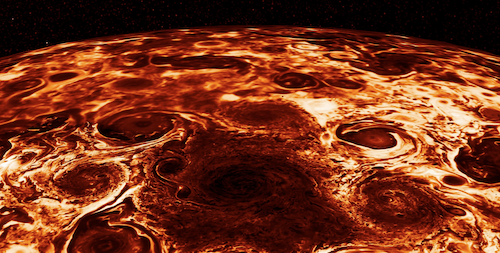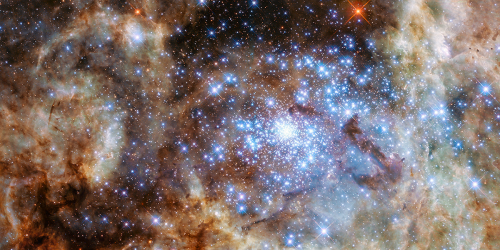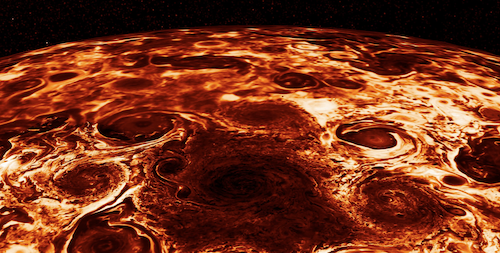July 16, 2025• Physics 18, s87
A spacecraft observes a new oscillation mode in the low-density plasma.
NASA; JPL-Caltech; SwRI; ASI; INAF; JIRAM

NASA; JPL-Caltech; SwRI; ASI; INAF; JIRAM
The Juno space probe has spent the past nine years observing Jupiter and its moons. As the spacecraft’s mission draws to a close, the precession of its orbit has caused its closest approach to the gas giant to shift toward the north pole, enabling it to uncover a surprise: an unusual pattern of plasma waves in the planet’s magnetosphere. Now Robert Lysak of the University of Minnesota and his colleagues describe these waves and propose a mechanism for generating them [1]. Their theory offers a new component to include in planetary magnetosphere models and opens a new plasma regime to further exploration.
According to textbook plasma physics, collective waves of electrons in a plasma called Langmuir waves tend to oscillate parallel to magnetic-field lines at a so-called plasma frequency that’s much greater than the ions’ angular frequency around these field lines, their gyrofrequency. Meanwhile, ions tend to oscillate perpendicular to magnetic-field lines as Alfvén waves, with an upper frequency limit corresponding to the ion gyrofrequency. The waves detected by Juno, however, departed from that paradigm: The Alfven waves’ frequency extended only to the plasma frequency, which was less than the ion gyrofrequency. And the waves’ frequency never exceeded the plasma frequency.
To account for the observed waves, Lysak and his colleagues analyzed the relationship between the waves’ frequency and wave number in the highly magnetized, low-density plasma of Jupiter’s magnetosphere and described a scenario in which Alfvén waves transitioned to Langmuir waves at large wave numbers. This behavior can be spurred by upward-propagating electron beams, with energies from 1 keV to 2 MeV. Juno first observed such beams in Jupiter’s northern polar regions in 2016.
The researchers say that this scenario should interest astronomers studying magnetized stars and exoplanets that have intrinsic magnetic fields.
–Rachel Berkowitz
Rachel Berkowitz is a Corresponding Editor for Physics Magazine based in Vancouver, Canada.
ReferencesR. L. Lysak et al., “New plasma regime in Jupiter’s auroral zones,” Phys. Rev. Lett. 135, 035201 (2025).Subject AreasPlasma PhysicsAstrophysicsRelated Articles

 More Articles
More Articles

